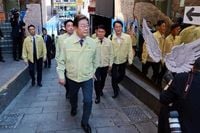On the afternoon of June 12, 2025, South Korean President Lee Jae-myung made an unscheduled visit to the Itaewon disaster site in Yongsan-gu, Seoul, marking a solemn moment of remembrance and reflection on one of the nation's most tragic recent events. This visit came immediately after President Lee concluded a thorough field inspection at the Han River Flood Control Center in Seocho-gu, where he had been assessing the country's preparedness for the ongoing monsoon season and potential flood threats.
President Lee’s stop at the '10·29 Path of Memory and Safety'—a memorial space near Exit 1 of Itaewon Station on Seoul’s Subway Line 6—was marked by a quiet but deeply respectful tribute. Donning a yellow civilian mourning band, he laid a bouquet of white chrysanthemums before a large memorial board bearing the names and faces of those lost in the October 29, 2022 disaster. Accompanied by senior aides including Chief of Staff Kang Hoon-sik, the President observed a moment of silence lasting approximately ten seconds, honoring the victims of the tragic crush that had devastated the area.
During his visit, President Lee took a careful walk along the path dedicated to the memory of the disaster, asking detailed questions about the site’s current state. He inquired whether the area had been densely crowded at the time of the disaster, if the families’ memorial altars were still maintained, and who was responsible for installing the various commemorative installations. These questions underscored his commitment to understanding the full scope of the tragedy and the ongoing efforts to honor those affected.
One poignant moment came as President Lee paused to read slowly from a large orange memorial board positioned on the main road, which began with the words: "The '10·29 Path of Memory and Safety' is unfinished. On the night of October 29, 2022, the disaster occurred here." This simple yet powerful statement encapsulated the ongoing need for remembrance and the pursuit of safety reforms to prevent such catastrophes from happening again.
Beyond paying respects, President Lee engaged with local merchants in the area, shaking hands and exchanging words. He showed a keen interest in the neighborhood’s economic health, asking how business had been faring in the aftermath of the tragedy. One particular question stood out: “What about the premium? If I see the premium, I can know the situation,” referring to the commercial rights or 'key money' that often reflect the vitality of small businesses in the district. These interactions revealed the President’s broader concern for the community’s recovery and livelihood.
The visit was not merely symbolic. Earlier that day, President Lee had presided over a flood preparedness meeting at the Han River Flood Control Center, where he emphasized the critical importance of robust flood prevention and warning systems amid the monsoon season. He urged public officials responsible for safety and disaster management to prioritize their duties, stressing that protecting the lives and well-being of citizens is their foremost responsibility.
In a briefing following the visit, presidential spokesperson Kang Yoo-jung explained that President Lee had urgently decided to visit the Itaewon site after the flood inspection, highlighting his deep concern for national safety. The spokesperson relayed the President’s firm stance that preventable disasters such as the Sewol Ferry tragedy, the Itaewon crush, and the Osong underground tunnel collapse were failures that must never be repeated.
President Lee called for a fundamental shift in the mindset surrounding safety management within the public sector. Recognizing that disaster and safety roles are often seen as undesirable or thankless, he pledged to improve the treatment, status, and authority of officials in charge of these critical functions. “The responsibility of public officials in safety management is heavy, and their authority must be expanded accordingly,” he stated, directing the development of a personnel reform plan that includes enhanced compensation and status for these workers.
He further emphasized that accountability for foreseeable disasters must be strict and unequivocal. “Predictable accidents caused by indifference or neglect must never happen under this administration,” President Lee asserted, underscoring the need for proactive safety measures and rigorous oversight.
During his roughly ten-minute stay at the disaster site, President Lee also reflected on a message inscribed on the ground: "There are still names we must remember." This served as a sobering reminder of the human cost of the tragedy and the enduring duty to honor those lost while ensuring such events do not recur.
The President’s visit attracted attention from citizens and local merchants alike, many of whom approached him for handshakes and photos. Some merchants shared their struggles, revealing difficulties in paying management fees and seeking political support to improve the lives of ordinary people in the area. These candid exchanges highlighted the intersection of disaster recovery with broader social and economic challenges faced by affected communities.
President Lee’s visit to Itaewon and the flood control center reflects a comprehensive approach to national safety—addressing both natural disasters and human-made tragedies with equal urgency. His administration’s focus on strengthening disaster preparedness, enhancing the roles and rewards of safety officials, and fostering community recovery aims to build a safer and more resilient South Korea.
As the country faces the unpredictable challenges of climate change and urban density, President Lee’s commitment to transforming safety protocols and public attitudes toward disaster management could mark a turning point. His insistence that “protecting the lives and safety of citizens is the most important task, even more so than economic or livelihood issues” sends a clear message about the priorities of his government.
In the shadow of past tragedies, the President’s visit to Itaewon serves not only as a tribute to those lost but also as a call to action—a reminder that vigilance, accountability, and compassion must guide the nation’s path forward.
![이태원서 머리 숙인 이 대통령…참사현장 즉석 방문 [포토]](https://thumbor.evrimagaci.org/rDvqH6zWCCwYzLOJ6YKZAlQzzIs=/200x0/tpg%2Fsources%2Fab914c49-3d0a-4668-b208-8307f2adac19.jpeg)

